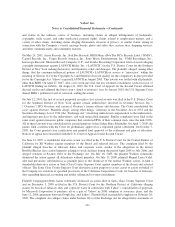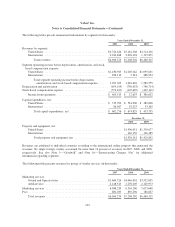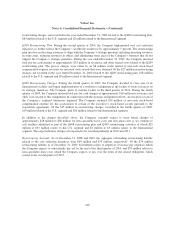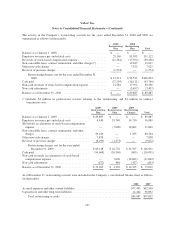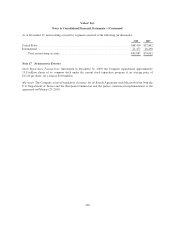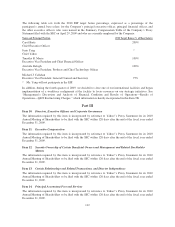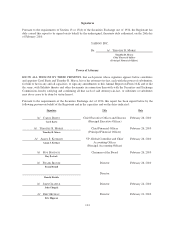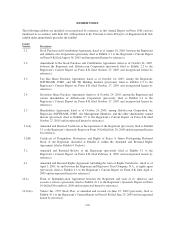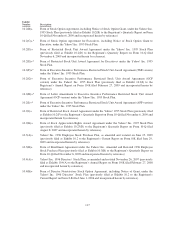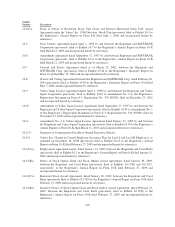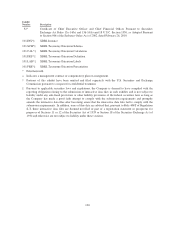Yahoo 2009 Annual Report Download - page 119
Download and view the complete annual report
Please find page 119 of the 2009 Yahoo annual report below. You can navigate through the pages in the report by either clicking on the pages listed below, or by using the keyword search tool below to find specific information within the annual report.Item 9. Changes in and Disagreements With Accountants on Accounting and Financial Disclosure
None.
Item 9A. Controls and Procedures
Evaluation of Disclosure Controls and Procedures
The Company’s management, with the participation of the Company’s principal executive officer and principal
financial officer, has evaluated the effectiveness of the Company’s disclosure controls and procedures (as such term
is defined in Rules 13a-15(e) and 15d-15(e) under the Exchange Act) as of the end of the period covered by this
report. Based on such evaluation, the Company’s principal executive officer and principal financial officer have
concluded that, as of the end of such period, the Company’s disclosure controls and procedures were effective.
Management’s Report on Internal Control Over Financial Reporting
The Company’s management is responsible for establishing and maintaining adequate internal control over
financial reporting as defined in Rules 13a-15(f) and 15d-15(f) under the Exchange Act. Under the supervision and
with the participation of the Company’s management, including its principal executive officer and principal
financial officer, the Company conducted an evaluation of the effectiveness of its internal control over financial
reporting based on criteria established in the framework in Internal Control—Integrated Framework issued by the
Committee of Sponsoring Organizations of the Treadway Commission. Based on this evaluation, the Company’s
management concluded that its internal control over financial reporting was effective as of December 31, 2009.
Because of its inherent limitations, internal control over financial reporting may not prevent or detect all
misstatements. Also, projections of any evaluation of effectiveness to future periods are subject to the risk that
controls may become inadequate because of changes in conditions, or that the degree of compliance with the
policies or procedures may deteriorate.
The Company’s independent registered public accounting firm has issued an attestation report regarding its
assessment of the Company’s internal control over financial reporting as of December 31, 2009, which appears
on page 57.
Changes in Internal Control Over Financial Reporting
There have not been any changes in the Company’s internal control over financial reporting (as such term is defined
in Rules 13a-15(f) and 15d-15(f) under the Exchange Act) during the most recent fiscal quarter that have materially
affected, or are reasonably likely to materially affect, the Company’s internal control over financial reporting.
Item 9B. Other Information
Executive Incentive Plan
On February 25, 2010, the Compensation Committee approved the Company’s 2010 annual cash bonus plan for
senior executives (the 2010 Executive Incentive Plan, or “EIP”). Each participant in the EIP is assigned a target
bonus percentage each year that is expressed as a percentage of the participant’s annual base salary. The aggregate
bonus pool available under the EIP for a particular year will equal the aggregate amount of the participants’ target
bonus opportunities, multiplied by a factor (the “Funding Percentage”) that may range from 50 percent to 200
percent based on Yahoo!’s operating income and revenue (each as defined in the EIP) for that year. Payout of 70
percent of each participant’s target bonus will be determined based on the Company’s performance, and the
remainder of the participant’s bonus will be determined based on that participant’s individual performance. The
individual performance component of a participant’s bonus will be determined by the Compensation Committee
with respect to executive officers of the Company and by management with respect to the other participants in the
EIP, except that in no event will the total amount of bonuses paid under the EIP for a particular year exceed the
aggregate bonus pool for that year. A participant generally must remain employed by the Company until EIP
bonuses are actually paid in order to be eligible for a bonus.
111


